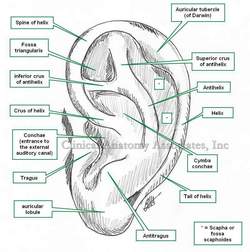|
The word [pinna] is Latin and means "feather". It also means "wing". The variation [penna] as in the case of [pennate], means "winged". It refer to the external ear, or auricle. It appears that the use of the term [pinna] for ear arises from the ear-like or winged extensions of viking and medieval helmets. The ear has three components, the internal, middle, and external ear. The external ear is composed of the external acoustic canal and the pinna. The pinna is composed of fibrocartilage covered with skin, and has several ligaments and small muscles related to it. These muscles are extrinsic (between the pinna and the skull) and intrinsic (within the pinna) All these muscles have limited capabilities in the human. The pinna receives blood supply from the anterior and posterior auricular arteries, and a small branch of the occipital artery. The nerve supply is by way of the great auricular nerve, the auricular branch of the vagus nerve, the auriculotemporal branch of the mandibular nerve, and the lesser occipital nerve. |
|
| The external (lateral) anatomy of the pinna is complicated and very detailed, with potential anatomical variations. Click on the image for a higher detail. The medial aspect of the pinna presents elevations which correspond to the depressions (fossae) on its lateral surface and they are named, eminentia conch?, eminentia triangularis, eminentia scaphoides, etc. | |
| Back to MTD Main Page | Subscribe to MTD |
